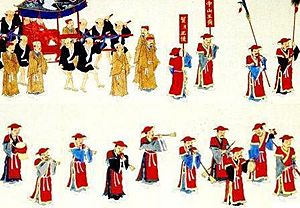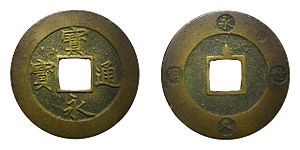Hōei facts for kids
The Hōei (pronounced Hoe-ay) was a special time period in Japan's history. It was a Japanese era name (called nengō) that lasted from March 1704 to April 1711. During this era, two emperors ruled Japan: Emperor Higashiyama and Emperor Nakamikado.
What Happened During the Hōei Era?
- November 11, 1707 (Hōei 4): A very powerful earthquake, known as the "Great Hōei Earthquake," shook Japan.
- December 16, 1707 (Hōei 4): Shortly after the earthquake, Mount Fuji erupted! Ash and cinders rained down on nearby areas like Izu, Kai, Sagami, and Musashi.
- 1708 (Hōei 5): The Japanese government (called the shogunate) started using new copper coins. Each coin had the Hōei era name stamped on it.
- April 28, 1708 (Hōei 5): A huge fire broke out in Heian-kyō, which was the old name for Kyoto.
- February 19, 1709 (Hōei 6): The shogun, Tokugawa Tsunayoshi, passed away. The shogun was the military ruler of Japan.
- 1709 (Hōei 6): Tokugawa Ienobu became the new head of the Tokugawa shogunate.
- August 7, 1709 (Hōei 6): Emperor Higashiyama decided to step down from his role (this is called abdicating). His son, Emperor Nakamikado, then became the new emperor in a special ceremony.
- January 16, 1710 (Hōei 6): The former Emperor Higashiyama died.
- July 7, 1710 – March 22, 1711 (Hōei 7 to Shōtoku 1): A group of diplomats from the Ryukyu Kingdom (now part of Japan) visited Edo, the capital city.
Related pages
- Edo period
- Hōei eruption of Mount Fuji
- National Diet Library, "The Japanese Calendar" -- historical overview plus illustrative images from library's collection
| Preceded by: Genroku |
Era or nengō: Hōei |
Succeeded by: Shōtoku |
Images for kids

All content from Kiddle encyclopedia articles (including the article images and facts) can be freely used under Attribution-ShareAlike license, unless stated otherwise. Cite this article:
Hōei Facts for Kids. Kiddle Encyclopedia.





